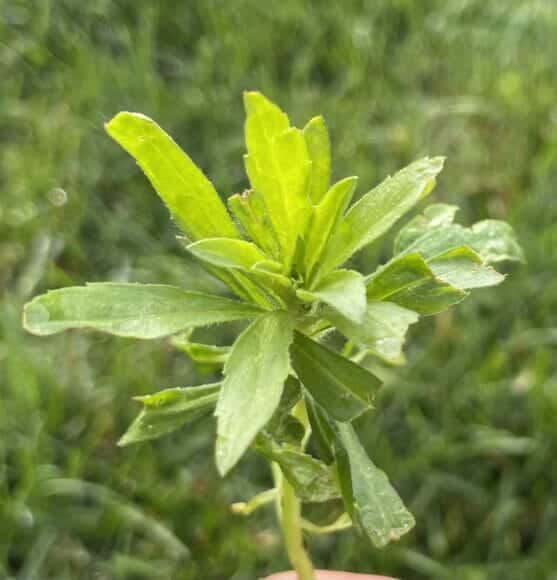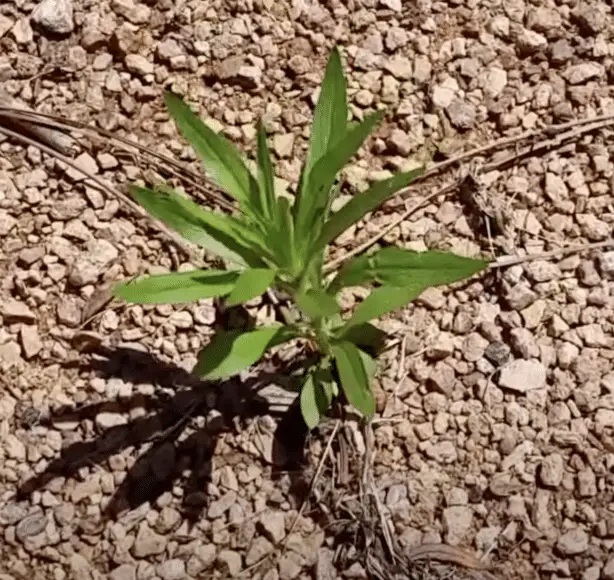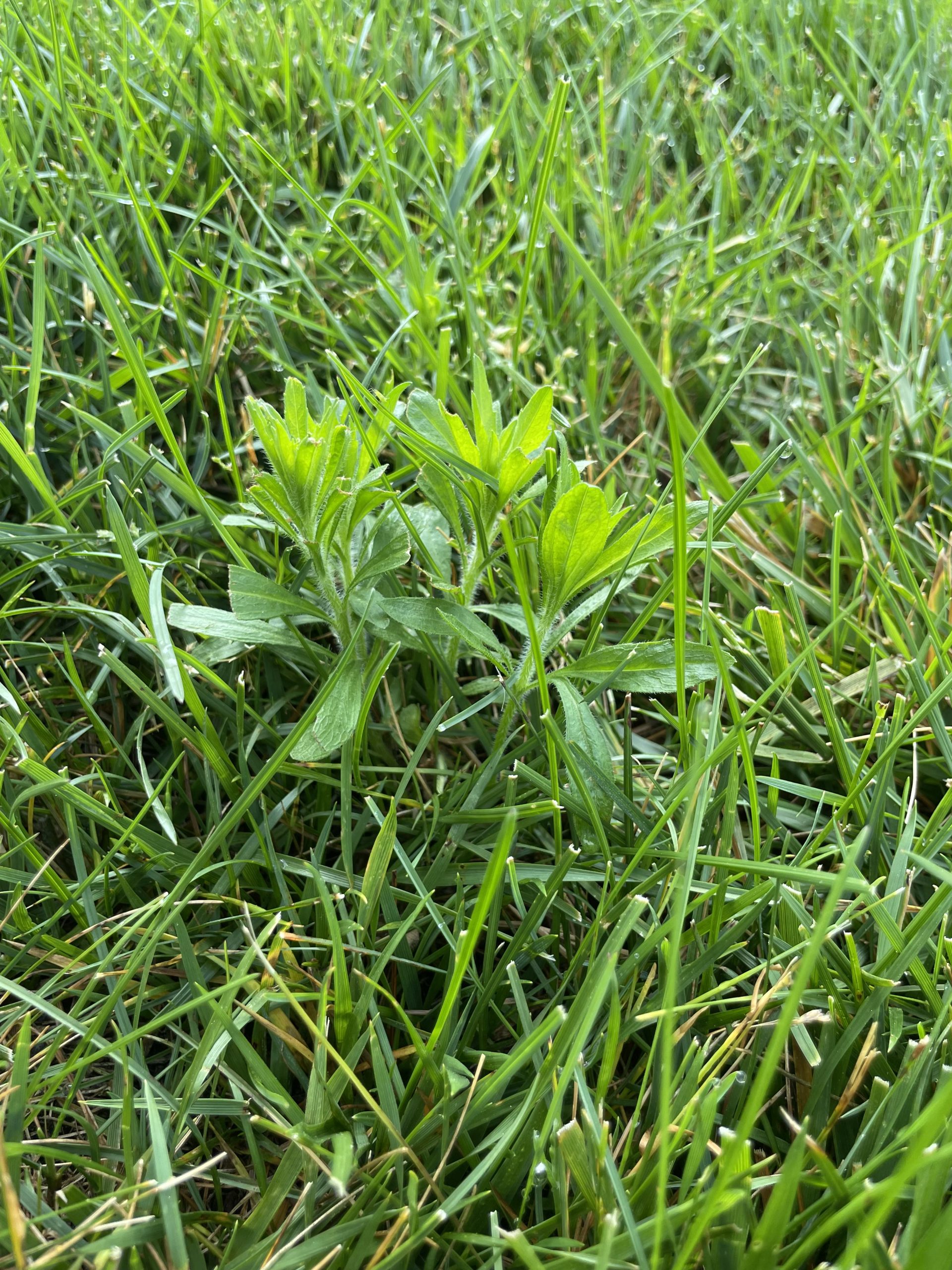An annual plant that grows throughout North America, horseweed is sometimes known as a mare’s tail or butterweed. Generally regarded as a noxious weed, horsetail can be highly problematic for lawns as it’s developed resistance to glyphosate, a non-selective weed killer. Horseweed is a summer annual that produces thousands of seeds that can remain dormant in the soil for a long time. Not only is common horseweed a problem for lawns, it can also have a strong impact on agricultural crops. Horseweed may also thrive in ditches, fields, and roadsides. The wind can carry its seeds quite far, making it easy for the species to spread.
Table of Contents
Horseweed Description & Identification
Horseweed, Conyza canadensis, is a member of the sunflower family. Horseweed can emerge in spring, fall, or summer. The plants can grow up to six feet tall. Horseweed is easy to identify by its bat-shaped leaves that are long and hairy with a bristly look. Near the top of the plant, its small branches feature small white flowers that resemble miniature daisies. The plant’s stem is usually single and erect, but several stems may exist.
Life Cycle of Horseweed Plant
The life cycle of the horseweed plant begins with seed germination. Horseweed will emerge as a rosette in the fall or spring, but fall is the usual time for this plant to emerge. The plant produces seeds between June and September and generally flowers in July. Each horseweed plant can produce roughly 200,000 seeds. Its seed production is excellent, but once dispersed, the seeds may not prove viable the longer they remain dormant. Even so, about 80% of the seeds germinate immediately. Plants develop a strong taproot; if stems are cut, they tend to regrow. As an annual weed, horseweed usually dies in winter; some plants may become dormant and survive the cold season if winter conditions are mild.
Similar Species to Horseweed
It may be confusing to identify horseweed as there are some similar plant species. For instance, goldenrod plants have similar leaves to horseweed. However, goldenrod flowers are yellow, while horseweed plants’ are white. Annual fleabane is also identical in appearance to horseweed. Annual fleabane leaves are more egg-shaped than horseweed, with baseball bat-shaped leaves and shorter hairs.
Additionally, common ragweed and horseweed are often mistaken for one another. However, while horseweed usually emerges in spring or fall, ragweed usually emerges between April and June. Fall-emerging horseweed will develop a rosette stage; ragweed does not have a rosette stage.
Controlling Horseweed in Lawn
It’s essential to take control of a horseweed infestation as soon as possible. As a prolific seed producer, horseweed can quickly overtake your lawn. You can keep this weed in check by controlling horseweed with both chemical and non-chemical controls. However, you want to control horseweed before it begins its seed production. Use the following strategies to prevent horseweed from overtaking your landscape and garden.



Cultural Practices
For best results, horseweed control should begin in fall. Many property owners choose to control horseweed by hand. They may pull out young plants before they develop into mature plants that are more difficult to control. However, the entire plant must be dug up or expect more plant emergence. It’s important to eradicate horseweed because it will compete with your preferred plants for water, owing to its rapid growth.
Chemical Control
Property owners often achieve horseweed control with chemical means. Targeting the plant during its fall rosette stage with a post-emergent herbicide is best. Chemicals including 2,4-d and Triclopyr, such as Crossbow and Speedzone, will kill horseweed. I use a mix of On Deck, Triclopyr, and a Non-Ionic Surfactant. Apply pre-emergent herbicide to the area in the fall to prevent fall emergence. Be prepared to follow up with a post-emergent herbicide in late fall should any rosettes emerge.
Herbicide Resistance
Like other weeds, horseweed has developed a resistance to common weed killers like glyphosate. Controlling horseweed is difficult if the stain growing on your property has become resistant to glyphosate.
Horseweed Plants FAQs
Should I pull up horseweed?
Yes, you should attempt to pull horseweed if the plant is young. If you have mature plants, you may want to pursue another method that involves chemicals. Hand-pulling horseweed tends to be most effective in early fall or when seedlings emerge.
How do you get rid of horseweed naturally?
The best method to get rid of horseweed is to pull up the seedlings while still young. Keep in mind that horseweed may have multiple stems. If you leave the stems or roots in the soil, the weed may continue to grow during its growing season. You should aim to control horseweed naturally by pulling out this weed species before its flowers bloom and it develops its seeds. Horseweed plants don’t always respond to herbicides, so hand pulling is often necessary for effective horseweed management.
Why is horseweed bad?
Horseweed is a noxious weed that proliferates and can use up natural resources in the soil that your lawn needs. Glyphosate-resistant horseweed is especially bad because it resists the most common and typically effective chemical weed control. Individual flower heads can produce horseweed seed in quantities of 200,000 that are easily dispersed, making this problematic weed challenging to eradicate, especially where it thrives in certain western states.
What is the best way to control horseweed?
Horseweed control is best managed when property owners can prevent seed production in the fall. Cultural controls for horseweed management include pulling up the plant from the soil. Keep in mind that stems can still grow if left in the soil. If you have a horseweed problem, you may want to apply a pre-emergent herbicide in late summer or early fall and a post-emergent herbicide after the weed appears.

